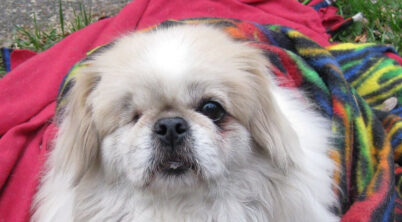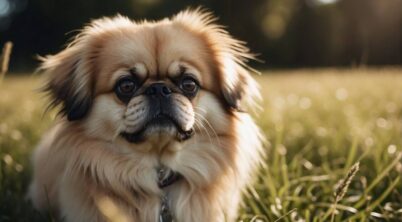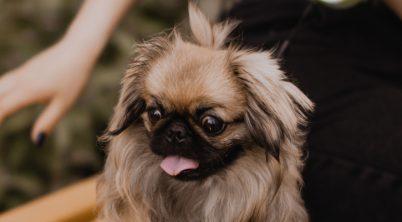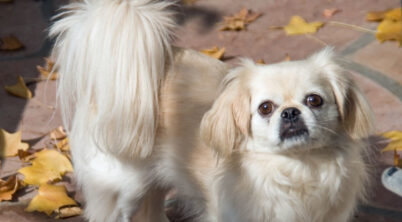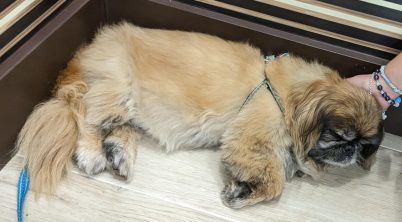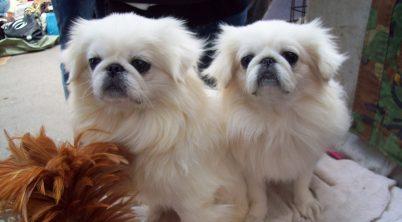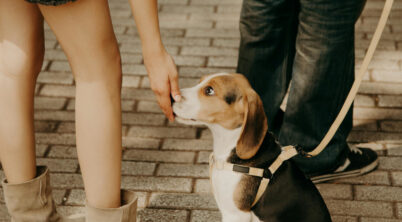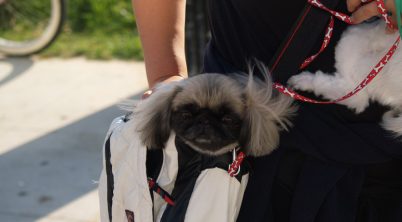The Pekingese, historically referred to as the lion dog, is a breed that has its roots deeply embedded in the ancient culture of China. Originating in the Chinese Imperial court, the breed was so revered that it could only be owned by members of the imperial family. The name Pekingese is derived from Beijing, formerly known as Peking, the city where the Forbidden City, the Chinese imperial palace, is located. This toy dog breed not only served as a companion but also held a significant place in Chinese mythology, associated with grand tales of origin that involve a lion.
Cherished for their unique appearance that displays a blend of dignity and nobility reminiscent of their storied lion ancestry, Pekingese possess a distinct flat face, pear-shaped body, and a character that sets them apart. They were once referred to as “Sleeve Pekingese,” a term that emerged from the practice of royals carrying these small dogs within the voluminous sleeves of their garments. Their companionship was highly valued, and their presence within the imperial family speaks to their esteemed status across centuries. Despite a somewhat stern appearance, Pekingese are known for their affectionate nature towards their owners, upholding their legacy as cherished royal companions.
The breed’s physical characteristics, such as their compact size, weighing typically between 7 to 14 pounds and standing around 6-9 inches tall, contribute to their popularity to this day. Pekingese have retained much of their traditional appeal while adapting well to modern pet ownership. Recognized by various kennel clubs and fanciers worldwide, they continue to be a symbol of cultural heritage and living history, a testament to the breed’s long-standing significance in China and its continuing legacy around the world.
Table of Contents
What is a Pekingese Monkey?
The term “Pekingese Monkey” may lead to some confusion. It does not refer to an actual monkey species but rather connects to a myth related to the Pekingese dog breed. Historically, the Pekingese — a toy dog breed with Chinese origins — was steeped in imperial legend. According to Chinese folklore, the breed was once believed to have been the offspring of a lion and a marmoset monkey.
The Pekingese boasts a distinct appearance characterized by its:
- Pear-shaped body: Compact and stocky
- Flat face: Known as brachycephaly
- Lion-like mane: Contributing to the lion aspect of the legend
In imperial China, owning a Pekingese was a luxury limited exclusively to the Imperial family. These canines were so revered that they were part of the royal court in Beijing (formerly Peking, hence the breed’s name).
Despite the fanciful legend, the Pekingese is clearly a dog, not a hybrid animal. They were bred for their unique size and appearance through careful selection of different small dog breeds by Chinese breeders, aiming to maintain the breed’s distinctive traits but not to literally blend canine and primate lineage.
It should be noted that the Pekingese’s lion-like aesthetic has a significant cultural importance. In Chinese symbolism, lions represent power and protection — attributes the Imperial household sought to reflect within their companion animals.
Breed Origins
The Pekingese breed has a rich tapestry of history that weaves through ancient China and into Western societies, marked by associations with royalty and notable historical events.
Ancient China and Imperial Ties
The Pekingese has its roots deeply embedded in the history of ancient China, primarily within the walls of the Chinese Imperial Palace. This toy dog breed was favored by the royalty of the Chinese imperial court and was seen as a living symbol of the lion—a creature revered in Buddhist tradition. A breed cultivated for centuries to resemble the lions of ancient lore, they were named after Beijing, formerly known as Peking, the city that housed the Old Summer Palace (Yuanmingyuan).
During the Second Opium War in 1860, the Old Summer Palace was looted by British and French soldiers, and it was during this conflict that the Western world was first introduced to the Pekingese breed. Among the looted treasures was a small Pekingese dog named Looty that was brought to Queen Victoria. It was a gift that would mark the beginning of the breed’s Western lineage and cement its status among the aristocratic families of Europe.
Pekingese in Western Culture
Once introduced to the West, the Pekingese’s association with Chinese royalty and its exotic origins captivated the imaginations of many, including prominent figures like Captain John Hart Dunne, who played a role in introducing the breed to British dog enthusiasts. Wealthy families, including the likes of financier John Pierpont Morgan, were instrumental in the breed’s proliferation across Europe and America.
As the breed became more established in the West, they maintained their status as a dog fitting for the elite. Despite the shifts in culture and geography, the Pekingese dog managed to preserve its noble and dignified demeanor, transitioning from the laps of Chinese emperors to the companions of European and American elites, and later, becoming cherished pets in homes around the world.
Physical Characteristics
The Pekingese breed boasts a unique appearance, characterized by a lion-like mane and a distinct rolling gait. This toy dog’s physical traits reflect its ancient Chinese heritage, designed to exhibit an air of nobility and allure.
General Appearance
The Pekingese presents a compact, well-balanced form with a notably dignified and regal bearing. They possess a heavy front and lighter hindquarters, with a body that is longer than it is tall. These dogs carry a confident presence, often moving with a slow, rolling gait suggestive of their royal past.
Coat and Colors
Their double-coat is long, course, and soft, demanding regular grooming to maintain its luxurious appearance. The Pekingese’s coat comes in an array of colors:
- Black
- White
- Cream
- Red
- Sable
- Fawn
- Gold
- Blue
- Parti-colors, such as white with patches of other colors
Markings can include a black mask or white accents. The tail is set high with an abundant fur, carried proudly over the back.
Head Structure
The head of the Pekingese is one of its most distinguishing features. It exhibits a broad, flat skull with a wide set between its large, round eyes. The muzzle is short and the overall expression is one of importance and self-importance. Ears are heart-shaped, set level with the skull and lying close to the head. The breed’s expression is enhanced by the mane of fur that frames the face, resembling that of a lion.
Breed Specific Traits
The Pekingese is a toy dog breed with a character that stems from its aristocratic roots in ancient China, often marked by a regal bearing. This breed is known for its distinct temperament—aloof yet affectionate towards its family, reflecting a sense of dignity. Pekingese dogs have a reputation for being loyal companions.
- Temperament: The Pekingese displays an independent streak, occasionally showing a playful side.
- Affection: They bond closely with their owners, often preferring a solitary owner or a quiet household.
Brachycephalic Airway Obstruction Syndrome is a significant health challenge in Pekingese due to their flat face and short nasal passage. Owners need to monitor their pets for signs of respiratory distress, especially in hot or humid weather.
| Health Problems | Description |
|---|---|
| Brachycephalic Airway Obstruction Syndrome | Respiratory issues related to short snouts. |
| Progressive Retinal Atrophy | Gradual deterioration of eyesight; can lead to blindness. |
| Other Health Concerns | They may face other issues like heart problems, skin infections, or orthopedic problems due to their compact size and structure. |
Owners should ensure regular check-ups to mitigate these health concerns and provide a comfortable living environment. It’s also essential to keep Pekingese in a cool environment to prevent overheating. Despite their small size, the Pekingese views the world with a regal outlook and expects to be treated with respect and gentleness that their royal ancestry would suggest.
Cultural and Historical Significance
The Pekingese breed boasts a storied past where it has been intertwined with Chinese royalty and cultural representation for over two millennia. This small dog, emblematic of sacred traditions, mirrors the likeness of lions believed to serve as guardians in ancient lore.
Role in Chinese History
The Pekingese, or “Peking Palasthund,” earned its noble status as a companion to the Chinese emperor and the imperial family. With origins dating back to the Han Dynasty, this breed was crafted to exemplify the courage and spirit of the lion, an important symbol in Buddhist culture. Such was their esteemed position that commoners had to bow to these dogs, and theft of a Pekingese was punishable by death. These toy dogs enjoyed luxuries of the palace life and were kept within the Forbidden City, adding to their aura of exclusivity.
Pekingese in Art and Literature
In the realms of art and literature, the Pekingese bears significant representation, often portrayed alongside figures of royalty and Buddha to signify their high rank and divine favor. Artistic depictions from ancient scrolls to modern paintings frequently include this breed as part of the sacred and royal iconography. Literature also reflects the Pekingese’s status—its likeness to a lion, not a monkey, enhances its portrayal as a dog of great valor and mythological connection, a cultural icon beyond the mere physical.
Contemporary Relevance
The Pekingese, a toy dog with a rich history, remains a cherished companion dog that is recognized by various kennel clubs. Its long-haired coat and distinctive rolling gait are characteristics that continue to charm dog enthusiasts.
Breed Popularity Trends
The Pekingese breed has experienced various phases of popularity. Historically revered by Chinese royalty, they have been regarded as a symbol of status and luxury. In modern times, their popularity fluctuates but they maintain a devoted following. The breed is not currently at the forefront of popular trends in dog ownership but does hold a consistent appeal among those who favor toy dog breeds for companionship.
- AKC Popularity Ranking (as of the last known update): 93rd out of 197 breeds
Club Recognitions and Standards
Kennel clubs around the world have recognized the Pekingese and have set breed standards that outline the ideal characteristics of the breed.
- American Kennel Club (AKC): Recognized the Pekingese as a member of the toy group, placing emphasis on its characteristic flat face, heart-shaped ears, and well-proportioned rolling gait.
- The Kennel Club (UK): Also recognizes the Pekingese, categorizing it within the Toy breeds, and has similar expectations of the breed’s physical characteristics and demeanor.
Breed Standards Focus:
- Size: Typically weighing between 7 and 14 pounds
- Coat: Long, flowing double coat
- Temperament: Confident, dignified, and good-natured
Through these standards, the clubs ensure that the Pekingese remains true to its heritage as an imperial Chinese breed.
Genetics and Breeding
The Pekingese breed boasts a rich genetic lineage that has been carefully sculpted through selective breeding practices. With defined breed standards and a notable pedigree, the Pekingese’s genetics speak to its long history and the meticulous efforts to maintain its distinct characteristics.
Breed Standards
The American Kennel Club (AKC) sets specific standards for the Pekingese breed. An adult male typically weighs between 8-12.5 pounds, while a female ranges from 9-13.5 pounds. The height should not exceed 9.75 inches, ensuring the breed’s characteristic compact stature. Coat colors vary extensively, and can include markings, but white or off-white fur and pink skin associated with albinism, caused by a variant in the SLC45A2 gene, is not standard.
- Weight:
- Male: 8-12.5 lbs
- Female: 9-13.5 lbs
- Height: 6-9.75 inches
- Coat: Various colors and markings
- Albinism: Not a standard trait
Pedigree and Lineage
The Pekingese is a member of the toy group and has a documented lineage tracing back about 2,000 years to the Chinese imperial family. Related to other small dog breeds such as the Shih Tzu and possibly the Maltese, the Pekingese has been bred specifically to maintain its lion-like appearance, rather than for purposes like hunting or guarding.
- Order: Carnivora
- Family: Canidae
- Notable Relations: Shih Tzu, Maltese
Pedigree is paramount in the breeding of Pekingese, as it ensures the purity and quality of the breed. Breeders often reference the dog’s pedigree, which includes its ancestral lineage, to highlight its conformity to the breed’s standards and its potential as a show dog.
Notable Pekingese Dogs
The Pekingese breed has a storied history with several dogs standing out due to their connection with historic figures and famous owners.
Historic Figures and Famous Owners
- Looty: The first known Pekingese to reach England was Looty, who was brought from Beijing in 1860 as a gift to Queen Victoria after the Second Opium War. She was one of five Pekingese dogs discovered in the Yuanming Yuan, the Summer Palace of the Emperor of China, by British and French troops.
- Duchess of Wellington: Another noted figure in the Pekingese history was the Duchess of Wellington. She, along with other aristocrats of the time, played a significant role in the breed’s prominence in England.
- Sir George Fitzroy: Sir George Fitzroy was one of the individuals who owned Pekingese dogs, which were considered valuable possessions and status symbols during the Victorian era.
- Manchu: A Pekingese named Manchu was gifted to Alice Roosevelt, the daughter of U.S. President Theodore Roosevelt, by the Empress Dowager Cixi of China in 1903.
- Hytien: Hytien, known for his distinctive appearance and owned by Lady Decies, became another famous Pekingese who contributed to the breed’s popularity among dog enthusiasts.
- Lord John Hay: A senior British naval officer, Lord John Hay was among the first to bring the Pekingese to British shores, following the sacking of the Summer Palace in Beijing.
Through their esteemed owners, these notable Pekingese dogs left their paw prints on the tapestry of history, reflecting the breed’s connection to nobility and its rise in popularity across the world.
Additional Information
Physical Characteristics: The Pekingese breed displays a vast array of coat colors including tan and red. They are known for their short, compact build, which is part of their charm and appeal.
Domestication: Their domestication is deeply rooted in Chinese history, particularly within the confines of the Imperial Court. They have been companions to royalty for centuries, symbolizing wealth and opulence.
Breeding: Historical accounts suggest that breeding programs in ancient China were overseen by eunuchs who were tasked with maintaining the purity of the breed. These breeding practices were meticulous and aimed to amplify the Pekingese’s distinctive physical traits.
Rare Varieties: While not commonly seen, there are instances of albino Pekingese. Albinism in dogs is a genetic condition that results in a lack of pigmentation in the coat and skin.
Health Considerations: Due to their distinctive facial structure, Pekingese have a pronounced facial arch which can contribute to certain health issues. Prospective owners should be aware of these potential health concerns and should seek dogs from reputable breeders who use health-conscious breeding practices.
| Trait | Description |
|---|---|
| Coat Color | Includes tan, red, and rare albino variants |
| Build | Short in stature |
| Domestication | Initially bred for Chinese royalty |
| Breeding Oversight | Often managed by eunuchs in historical contexts |
| Facial Structure | Pronounced arch can lead to health issues |
This section offers brief insights into characteristics and historical aspects of the Pekingese, contributing a clear understanding without overstating or embellishing the facts.

